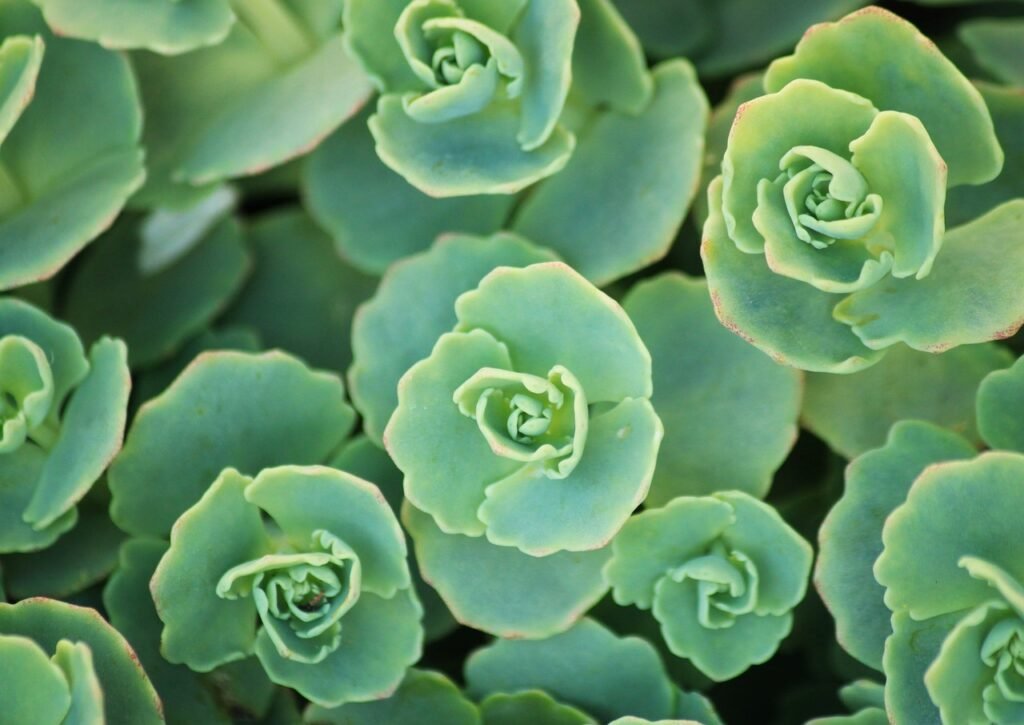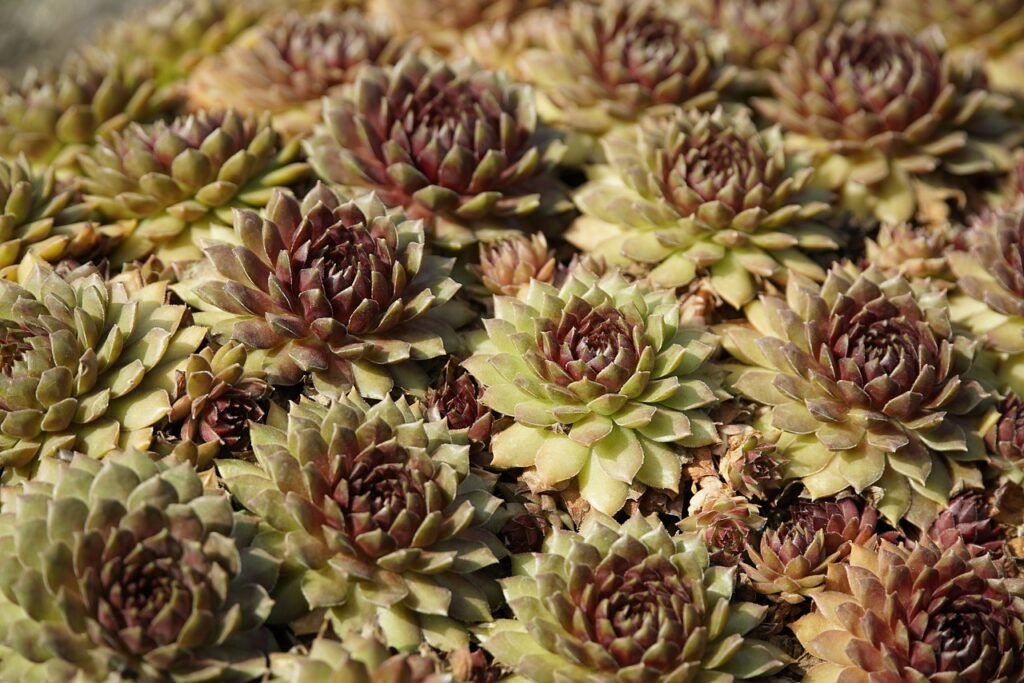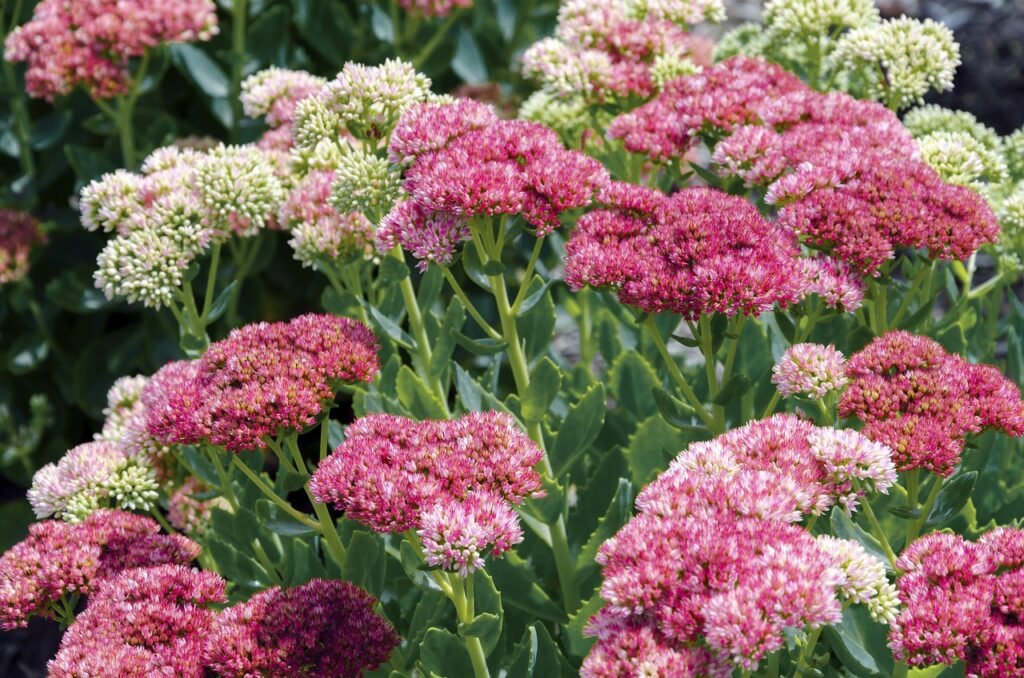Sedum | Stonecrop : Everything you need to know!

If you’re a fan of low-maintenance, drought-tolerant plants that add a pop of color to your garden, then you’ll want to learn all about Sedum/Stonecrop.
In this comprehensive guide, we’ll cover everything from the different types of Sedum/Stonecrop to how to grow and use them in landscaping.
We’ll also explore the potential benefits of growing Sedum/Stonecrop, as well as the potential problems you might encounter.
And for those interested in herbal remedies, we’ll even delve into the medicinal uses of Sedum.
So, grab your gardening gloves and let’s dive in!
Key Takeaways:
- Sedum, also known as stonecrop, is a versatile and low-maintenance plant that comes in a variety of types.
- When growing sedum, it is important to consider its soil and sun requirements, watering and fertilizing needs, and propagation methods.
- Aside from its aesthetic appeal, sedum also has practical benefits such as being low maintenance, drought tolerant, and attracting pollinators.
What Is Sedum/Stonecrop?
Sedum, commonly known as stonecrop, is a genus of flowering plants that belong to the Crassulaceae family. These succulent plants are known for their fleshy, water-storing leaves and vibrant, star-shaped flowers.
Sedum plants are versatile and can be found in a wide range of shapes, sizes, and colors. They are often used in rock gardens, containers, and ground covers, adding texture and visual interest to the landscape.
Stonecrop, another common name for sedum, reflects the plants’ ability to thrive in rocky or stony environments. These hardy plants are low-maintenance and drought-tolerant, making them popular choices for xeriscaping and low-water gardens.
What Are The Different Types Of Sedum/Stonecrop?
The different types of sedum and stonecrop encompass a wide range of species and cultivars, each boasting unique characteristics, growth habits, and visual appeal. From creeping sedum to upright and mat-forming varieties, there is a diverse selection to explore and cultivate.
Creeping Sedum
Creeping sedum, including varieties like Sedum reflexum and Sedum sexangulare, is characterized by their low-growing, spreading nature, making them ideal for ground cover and rock gardens. These sedums thrive in sunny, well-drained locations and offer a delightful tapestry of foliage and blooms.
Sedum reflexum, also known as Stonecrop, features clusters of tiny, star-shaped yellow flowers that emerge in summer, adorning its blue-green foliage.
On the other hand, Sedum sexangulare, commonly referred to as Tasteless stonecrop, displays bright yellow, star-shaped flowers against its green, needle-like leaves.
Both varieties are drought-tolerant and require minimal maintenance, making them popular choices for landscaping and xeriscaping projects.
These sedums are also adaptable to various soil types, as long as they are well-draining, and are perfect for adding visual interest to slopes, crevices, and containers.

Upright Sedum
Upright sedum, including popular cultivars like Sedum Autumn Joy and Sedum Matrona, presents tall, clump-forming habits with striking flower heads that transition through captivating color changes. These sedums are prized for their vertical interest and resilience in various growing conditions.
Upright sedum is known for its ability to thrive in poor soil and drought conditions, making it a great choice for low-maintenance and water-wise landscapes. One popular variety, Sedum Autumn Joy, features rose-pink blooms that turn coppery red as they mature. Another standout cultivar, Sedum Matrona, boasts robust, purple-tinged foliage and rosy-pink flowers. These sedums prefer full sun and well-drained soil, and their succulent leaves help them retain water, reducing the need for frequent watering. Additionally, their attractive blooms attract pollinators, providing ecological benefits.
Mat-forming Sedum
Mat-forming sedum, exemplified by varieties like Sedum Angelina and Sedum Lime Zinger, exhibits spreading, ground-hugging growth habits with vibrant foliage colors that add visual interest to borders and containers. These sedums thrive in various soil types and are valued for their ease of care.
The Sedum Angelina, with its chartreuse needle-like foliage, forms a dense mat of foliage that turns orange in cooler temperatures.
The Sedum Lime Zinger showcases striking lime-green foliage that develops pink edges in the cooler months, creating stunning color contrasts.
These varieties are ideal for rock gardens, slopes, and containers, as they offer low-maintenance ground cover and excellent erosion control.
How To Grow Sedum/Stonecrop?
Growing sedum and stonecrop plants involves providing the right soil and sun conditions, managing watering and fertilization, and utilizing effective propagation methods to establish thriving and resilient succulent displays.
To ensure the optimal growth of sedum and stonecrop plants, it’s essential to understand their specific soil and sunlight requirements.
These hardy succulents thrive in well-draining soil with a slightly acidic to neutral pH. A mixture of sandy soil and perlite or pumice can promote excellent drainage while preventing waterlogging. Additionally, sedum and stonecrop plants excel in direct sunlight and require at least six hours of sun exposure daily.
In terms of watering, it’s crucial to strike a balance. Overwatering can lead to root rot, while underwatering may cause the plants to wilt. It’s advisable to water the plants deeply but infrequently, allowing the soil to dry out between waterings.
As for fertilization, a balanced, diluted succulent fertilizer applied sparingly during the growing season can aid in healthy growth without risking fertilizer burn.
Propagation methods for sedum and stonecrop include stem cuttings, division, and leaf cuttings. Stem cuttings can be rooted in a well-draining medium, while division involves separating mature clumps carefully. Leaf cuttings can be laid on a suitable substrate until roots develop. These techniques can help expand your sedum and stonecrop collection, creating a stunning succulent garden.

Soil and Sun Requirements
The successful cultivation of sedum hinges on well-draining soil, ample sunlight exposure, and proper care practices to ensure the optimal growth and development of these resilient succulent plants.
In terms of the soil, sedum demands soil that provides excellent drainage, preventing waterlogged conditions that could lead to root rot.
Sandy or rocky soil types are recommended, but if you have heavy clay soil, amending it with coarse sand or perlite can improve drainage. Ensuring that the soil pH is slightly acidic to neutral is beneficial for sedum growth.
Regarding sunlight exposure, sedum thrives in full sun, requiring a minimum of 6 hours of direct sunlight each day.
Placing them in a location with partial shade may result in leggy growth, reducing their overall vigor and beauty.
As for care practices, it’s essential to avoid overwatering, particularly in humid climates, as sedum are susceptible to fungal diseases.
Mulching can help retain moisture while also preventing weed growth, but be sure not to smother the plant stems.
Regular inspection for pests and signs of stress is crucial to promptly address any issues and ensure the continued health of your sedum plants.
Watering and Fertilizing
Proper watering and fertilizing practices are essential for the health and vigor of sedum plants, requiring a balanced approach to moisture management and nutrient supplementation to support their succulent growth and resilience.
It is crucial for sedum to be planted in well-draining soil to prevent waterlogging. Excessive moisture can lead to root rot and other issues. When watering, it’s best to allow the soil to dry out between sessions to prevent overwatering.
In terms of fertilizing, a balanced fertilizer with low nitrogen content should be applied sparingly in early spring. This promotes healthy growth without encouraging excessive foliage at the expense of blooms. For ongoing care, a slow-release fertilizer or diluted liquid fertilizer can be applied every 6-8 weeks during the growing season to provide necessary nutrients for sedum plants.
Mulching can also be beneficial for sedum by helping to retain moisture and reduce weed growth around the plants. This contributes to overall care and maintenance for healthy sedum plants.

Propagation Methods
The propagation of sedum involves various methods such as division, stem cuttings, and leaf propagation, enabling gardeners to expand their sedum displays and cultivate new plants with effective care and attention.
Division is one of the most common and straightforward methods for increasing the sedum collection. This process involves separating mature clumps into smaller sections, each with their own roots, to encourage new growth.
Another popular technique is stem cuttings, where healthy stems are cut from the parent plant and then placed in a suitable growing medium, such as a well-draining potting mix. Over time, these cuttings develop their own root systems and eventually mature into independent plants.
Leaf propagation is also a viable method, especially for certain sedum varieties. By carefully removing individual leaves from the parent plant and allowing them to callous before placing them in a lightly moistened growing medium, gardeners can witness the development of new roots and plantlets. This approach requires careful monitoring of humidity levels to ensure successful establishment.
What Are The Benefits Of Growing Sedum/Stonecrop?
Growing sedum and stonecrop offers various benefits, including their low maintenance requirements, drought tolerance, and the ability to attract pollinators, making them valuable additions to diverse landscapes and garden settings.
With their striking foliage and colorful flowers, sedum plants bring an aesthetic appeal to any garden or landscape. The sedum ground cover not only adds visual interest but also acts as a natural insulator, protecting the soil from erosion and temperature fluctuations.
The drought-resistant nature of sedum and stonecrop makes them ideal choices for regions with minimal rainfall or for gardeners seeking low-maintenance greenery. Their ability to thrive in arid conditions reduces the need for frequent watering and upkeep, saving both time and resources.
Beyond their visual and practical advantages, sedum and stonecrop attract a variety of pollinators like butterflies and bees, contributing to the overall health of the garden ecosystem. Their nectar-rich blossoms provide a valuable food source for these beneficial insects, supporting biodiversity and aiding in the pollination of other plants.
Low Maintenance
One of the key benefits of sedum is its low maintenance nature, requiring minimal care and attention while still thriving in a variety of environmental conditions, making it an ideal choice for gardeners seeking easy-to-manage plants.
It’s remarkable how sedum can flourish with so little effort. These hardy succulents are known for their adaptability, able to thrive in poor soil conditions and requiring very little water.
They can withstand both drought and extreme temperatures, making them a hassle-free addition to any garden. Their pest and disease resistance minimize the need for constant monitoring and treatment, freeing up time for other gardening tasks. With sedum, minimal care leads to an abundance of natural beauty.

Drought Tolerant
Sedum’s exceptional drought tolerance makes it a valuable ground cover option, as it can thrive in arid conditions and contribute to water-wise landscaping efforts, showcasing its adaptability and environmental benefits.
Its succulent leaves and ability to store water enable various sedum varieties to withstand prolonged dry spells, making them an ideal choice for regions with limited water availability.
Their low maintenance requirements and ability to prevent soil erosion also significantly enhance their appeal as a ground cover. They not only add visual interest to outdoor spaces but also play a crucial role in reducing water consumption and promoting sustainable landscaping practices.
Attracts Pollinators
Sedum’s vibrant flowers and nectar-rich blooms attract pollinators such as butterflies and bees, contributing to the biodiversity of garden spaces and promoting ecological balance through its role in supporting beneficial insect populations.
Sedum’s floral appeal doesn’t just add beauty to the landscape; it plays a crucial role in providing nectar resources for pollinators, which are essential for the reproduction of various plant species.
The diverse range of colors and shapes of sedum flowers further enhances their attractiveness to a wide array of pollinators, thereby enriching the local ecosystem. By hosting these pollinators, sedum actively facilitates the process of cross-pollination, contributing to the health and genetic diversity of plant communities in the area.
What Are The Potential Problems With Sedum/Stonecrop?
While sedum and stonecrop are generally resilient, they can face challenges such as susceptibility to pests and diseases, issues related to overcrowding, and considerations regarding winter hardiness, which require attention and proactive management.
One of the common challenges faced by sedum and stonecrop is their vulnerability to pests such as aphids, scale insects, and mealybugs. These pests can not only damage the foliage but also weaken the plants, making them more susceptible to diseases.
In addition, overcrowding can be a significant problem for these plants as they tend to spread and multiply rapidly. When they become overcrowded, it can lead to poor air circulation, increased moisture, and competition for nutrients, which may affect their overall health and growth.
Furthermore, sedum and stonecrop also require special attention when it comes to winter hardiness. While they are generally frost-resistant, certain varieties may struggle in extremely cold conditions, and inadequate protection during winter can lead to damage or even the death of the plants.

Pests and Diseases
Sedum can be susceptible to certain pests and diseases, including issues such as aphids, snails, and fungal infections, necessitating proactive monitoring and suitable care practices to minimize potential damage and preserve plant health.
Aphids, which are small insects that feed on plant sap, can be controlled by regularly inspecting the undersides of sedum leaves and using gentle sprays of water or insecticidal soaps.
To deter snails, creating barriers like crushed eggshells or copper tape around the base of the plants can be effective.
Maintaining proper spacing between sedum plants and providing adequate air circulation can help prevent fungal infections.
Proper soil drainage and avoiding overwatering are crucial for maintaining sedum’s resilience against these potential threats.
Overcrowding
The issue of overcrowding can affect sedum, particularly ground cover varieties, leading to competition for resources and potential decline in plant vitality, necessitating strategic spacing and maintenance to address this concern effectively.
Proper spacing plays a crucial role in the health and aesthetics of sedum displays. Overcrowding not only diminishes the visual appeal but also hinders air circulation and sunlight exposure, impacting the overall vigor of the plants.
In addition, dense growth may increase the risk of pest infestations and diseases due to limited airflow. Through regular thinning and spacing adjustments, gardeners can promote healthy growth, reduce competition, and maintain the allure of their sedum ground cover. This practice is essential for ensuring sustainable, thriving displays that showcase the beauty of these versatile plants.
Winter Hardiness
The winter hardiness of sedum can vary among different varieties, requiring attention to cold tolerance and suitable protective measures to ensure the survival and regrowth of these resilient plants during harsh winter conditions.
In terms of sedum species, it’s crucial to consider their natural adaptations for withstanding cold temperatures. This includes taking into account the potential impact of snow and ice on their foliage. Some varieties, like Sedum spectabile and Sedum acre, are known for their excellent cold tolerance. However, other varieties may benefit from strategies such as mulching and being placed in sheltered locations. By understanding the specific winter hardiness needs of each sedum variety, you can greatly contribute to their overall health and vigor.

How To Use Sedum/Stonecrop In Landscaping?
Sedum and stonecrop offer versatile options for landscaping, whether as ground cover elements, container garden features, or components of rock gardens, adding visual appeal, texture, and resilience to diverse outdoor settings.
These hardy succulents thrive in various conditions and require minimal maintenance, making them ideal for creating low-maintenance and drought-tolerant landscapes.
Their vibrant foliage and blooms attract butterflies and pollinators, contributing to the ecological balance of the garden. Sedum and stonecrop species such as ‘Dragon’s Blood’ and ‘Angelina’ are particularly popular for their ability to spread and provide lush coverage, enhancing the overall aesthetic of the landscape.
Ground Cover
Sedum’s ground cover capabilities make it an excellent landscaping choice, offering erosion control, weed suppression, and visual interest, while requiring minimal maintenance, making it an ideal solution for diverse outdoor spaces.
Given its resilience, sedum is widely used to stabilize soil on slopes, prevent erosion, and enhance the overall appearance of landscapes. The dense, low-growing foliage effectively blocks out unwanted weeds, providing a tidy and low-maintenance ground cover.
Additionally, sedum plants come in a variety of colors, textures, and flowering patterns, adding aesthetic appeal to gardens, walkways, and rockeries. Their ability to thrive in various climates and soil types further contributes to their versatility as a ground cover option.
Container Gardening
Sedum’s adaptability and visual allure make it a desirable choice for container gardening, offering versatility, resilience, and the opportunity to showcase various sedum varieties in portable, decorative displays.
These hardy succulents thrive in different conditions, from full sun to partial shade, making them adaptable to a variety of outdoor and indoor spaces. Their low maintenance requirements and ability to withstand drought make sedum an ideal fit for container gardening, especially for those with busy schedules or limited gardening experience.
The diverse range of sedum varieties, with their unique foliage colors, shapes, and textures, provides a plethora of options for creating visually stunning arrangements in containers. From the cascading beauty of Sedum spurium ‘Dragon’s Blood’ to the compact charm of Sedum rupestre ‘Angelina,’ there’s a sedum variety to suit every container gardening enthusiast’s taste and preference.
Rock Gardens
Sedum’s ability to thrive in well-drained, rocky environments makes it an ideal candidate for rock gardens, contributing to the dynamic textures, colors, and resilience of these landscaping features, creating captivating, low-maintenance displays.
Its adaptation to rocky terrains allows it to blend seamlessly with the natural aesthetics of rock gardens, where its succulent leaves and vibrant flowers accentuate the rugged beauty of the surroundings.
Additionally, sedum varieties offer diverse foliage colors, from deep greens to purples and silvers, enriching the visual tapestry of the garden.
The hardiness and drought tolerance of sedum further enhance its appeal, as it requires minimal watering and maintenance, making it a pragmatic choice for low-maintenance landscaping.
Its versatility in ground cover, as well as container and rockery plantings, provides flexibility in designing visually striking, sustainable outdoor spaces.

Medicinal Uses for Sedum
Sedum, particularly varieties like Sedum reflexum and related stonecrop succulents, holds a historical legacy of medicinal uses, with applications ranging from traditional remedies to contemporary herbal preparations, offering potential health and wellness benefits.
These sedum varieties have been traditionally used as potent remedies for ailments like digestive issues, skin conditions, and respiratory problems. Across various cultures and regions, Sedum reflexum and other stonecrop succulents have been incorporated into herbal treatments to alleviate symptoms of coughs, colds, and arthritis.
Their therapeutic potential is attributed to their rich composition of bioactive compounds, including antioxidants, flavonoids, and alkaloids, which contribute to their anti-inflammatory, antimicrobial, and immune-boosting properties. Some studies suggest that certain extracts from Sedum species may possess anti-cancer properties and could aid in managing diabetes and cardiovascular health.
While contemporary research continues to unveil the depth of sedum’s medicinal significance, its historical relevance and traditional applications serve as an invaluable source of exploration and potential advancement in natural medicine.
History of Sedum medicinal uses
The history of sedum’s medicinal uses traces back through various cultures, encompassing traditional herbal remedies, folklore practices, and contemporary explorations into the potential health benefits offered by these resilient and versatile succulent plants.
Throughout history, sedum has been valued for its medicinal properties across different civilizations. In traditional herbal practices, it was utilized to treat various ailments, ranging from skin wounds to digestive issues.
Cultural folklore often attributed mystical powers to sedum, leading to its incorporation in rituals and ceremonies. In modern times, researchers have delved into the therapeutic potential of sedum, uncovering its rich composition of beneficial compounds and highlighting its possible applications in alternative medicine and pharmacology.
Toxicity of Sedum to Pets and People
While sedum is generally considered non-toxic, some varieties may pose mild risks to pets and people if ingested, highlighting the importance of understanding potential toxicity levels and implementing precautions to ensure the safe enjoyment of sedum in various settings.
It’s important to recognize that pets, especially cats and dogs, may be curious about sedum and potentially nibble on its leaves or flowers. Some varieties of sedum contain substances that, if ingested in significant quantities, can lead to symptoms like vomiting, diarrhea, or irritation. While severe poisoning is rare, it’s essential for pet owners and caregivers to recognize the potential risks and take steps to prevent accidental ingestion.
Creating awareness about the potential toxicity of certain sedum varieties can help pet owners create a safe environment for their furry companions. It’s advisable to place sedum in locations that are not easily accessible to pets or use barriers to prevent them from reaching the plants. Familiarizing oneself with the specific sedum varieties and their potential risks is crucial for responsible plant care. Should accidental ingestion occur, seeking immediate veterinary advice is paramount to ensure the well-being of pets.
Similarly, for households with young children, educating them about the risks associated with consuming sedum can instill proper precautions. It’s recommended to teach children not to ingest plants and to seek adult supervision when they are around sedum or any other potentially hazardous plant. By promoting awareness and responsible practices, individuals can enjoy the beauty of sedum while ensuring the safety of their loved ones and pets.
Conclusion
In conclusion, sedum and stonecrop stand as versatile and resilient additions to gardens and landscapes, offering an array of benefits, uses, and potential health applications, making them valuable assets in horticulture and ecological endeavors.
These hardy plants are renowned for their ability to thrive in various climates and soil conditions. They require minimal maintenance and add visual appeal to outdoor spaces. Their versatility extends to their uses in landscaping.
They can be employed as ground cover, in rock gardens, or as container plants, enhancing the aesthetic value of any garden. The potential health applications of these succulents are being increasingly recognized. Their natural properties are being harnessed for wellness and therapeutic benefits.
Frequently Asked Questions
Sedum, also known as stonecrop, is a genus of flowering plants that belong to the Crassulaceae family. They are hardy, succulent perennials that come in a wide variety of shapes, sizes, and colors.
There are over 600 species of Sedum, each with its own unique characteristics and growth habits. Some popular types include Sedum spurium, Sedum spectabile, and Sedum kamtschaticum.
Sedum is a relatively low maintenance plant that thrives in well-draining soil and full sun. They require minimal watering and can withstand drought conditions. It’s important to avoid overwatering, as this can cause root rot.
Yes, certain types of Sedum can be grown indoors, as long as they receive enough sunlight and are planted in well-draining soil. They also make great additions to indoor succulent gardens.
The best time to plant Sedum is in the spring or fall when the temperatures are mild. This allows the plant to establish its roots before the hot summer or cold winter months.
Sedum not only adds beauty to your garden with its colorful flowers and foliage, but it also has several benefits. They attract pollinators, are drought tolerant, and can help prevent soil erosion. Some species also have medicinal properties.



